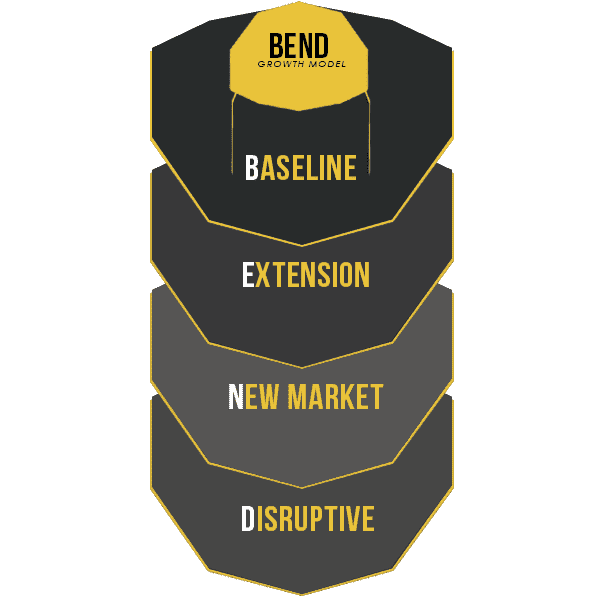Geoffrey Moore introduced the technology sector to the Technology Adoption Life-Cycle (1). He documented the stages every product or service goes through. He explained how growth varies at each stage. It’s slow during the early adopter phase, speeds up during the early majority then slows and declines in the late majority and laggard phases.
Vendors with all of their products in the early majority phase don’t have an immediate problem with growth. For everyone else, growth presents a challenge. Outcome-based vendors understand the Technology Adoption Lifecycle applies to them. So, they constantly plan for new sources of growth. And they use a new lens to plan that growth – the success outcome they serve.
BEND Growth Model

The four types form a somewhat fortuitous acronym – BEND. It’s fortuitous as vendors need a flexible growth planning framework. The industry changes quickly. Vendors need a growth planning process that can adapt or bend to suit the changing environment.
Outcome-based growth planning uses four different types of growth –
• Baseline
• Extension
• New-Market
• Disruptive
Baseline
Most vendors want to sell more of their existing products. Defining a success outcome provides a new perspective on your products and services. Do your products and services enable the success outcome? With this lens, you might identify quick changes you can make to your current offering. You might also identify elements of your offering which aren’t important to the success outcome. Removing unnecessary elements may simplify implementation and reduce costs.
You’ll increase sales by tuning your current offering to the success outcome you serve.
Extension
Baseline Growth focuses on increasing sales of existing products and services. Extension Growth identifies new products and services you might offer. There are four types of extension growth – bridging the outcome gap, end-consumer outcomes, higher-level outcomes and secondary outcomes.
Each one prompts thinking of new products and services you could add to extend your current range.
New-Market
For most vendors, it’s tough to break into a new industry. A lack of reference accounts in the new industry often proves the biggest challenge. Outcome-based Customer Success provides a new way to overcome this challenge.
You currently serve a success outcome in one industry. There will be other industries with a similar success outcome. Instead of industry references, you can use outcome references ie your ability to enable a success outcome common to both industries.
This overcomes the need for industry references and provides entry to the new industry.
Disruptive
Most vendors would love to grow by disrupting the market they serve. We see more and more disruptive products and services, some producing spectacular results for the disruptor. We provide three methods for generating ideas to disrupt – New Delivery, Add-on Outcome and new Outcome.
Choosing What to Do.
Outcome-based vendors plan for growth regularly. They create lots of innovative ideas. They’ll almost always have too many ideas to implement them all. The next step is to sort and prioritise the ideas then generate a practical action plan.
Outcome-based Customer Success uses a concept called Capability Circles to sort then prioritise the ideas. You’ll then build a practical plan to execute the ideas you’ve chosen.
(1).Crossing the Chasm; Moore, Geoffrey A. 1991 Harper Business
